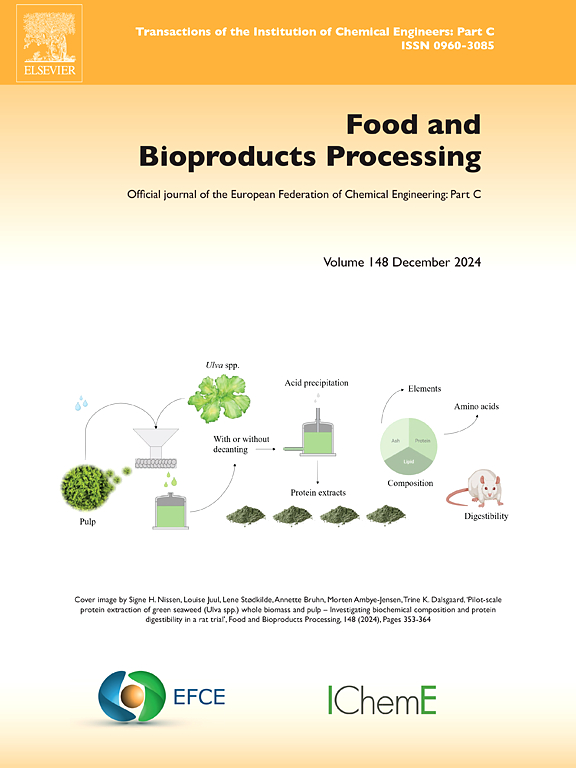Phase-separation wet spinning for fabricating composite fibers with protein-polysaccharide multicrosslinked structures: From plant proteins to livestock meat
IF 3.4
2区 农林科学
Q2 BIOTECHNOLOGY & APPLIED MICROBIOLOGY
引用次数: 0
Abstract
Meat analogs serve as a promising alternative to traditional meat consumption, addressing human health needs, promoting environmental sustainability, and tackling food security challenges. However, achieving parity in texture and flavor with traditional meat remains a critical area for enhancement. In this study, soy protein isolate (SPI) was employed as the primary protein source, while carrageenan (CG) and sodium alginate (SA) acted as carriers. A phase-separation wet spinning approach was used to construct SPI/SA/CG fibers with a robust hydrogen-bonded and ion-coordinated multicrosslinked network structure. The fibers were comprehensively analyzed for their textural attributes and digestive behavior. The SPI content increased the apparent viscosity of SPI/SA/CG solutions, enhanced their non-Newtonian behavior, raised the structural viscosity index, and reduced spinnability. The SPI/SA/CG fibers exhibited multiple hydrogen bonds and metal coordination interactions, with the type and strength of hydrogen bonding dependent on SPI content. SPI was predominantly present in β-sheet and β-turn conformations within the fibers. Within the operational temperature range of 40–78°C, SPI/SA/CG fibers displayed excellent thermal stability, experiencing minimal mass loss of just 4 %-6 %. The moisture content of SPI/SA/CG fibers closely matched that of livestock meat, with a maximum value of 79.51 %. Texture analysis confirmed that SPI/SA/CG fibers had a texture comparable to real beef, with the elasticity and cohesiveness of SPI2.25/SA/CG fibers achieving a similarity of up to 94 % to beef. Further digestion analysis validated the efficient release and digestion of SPI/SA/CG fibers under simulated gastrointestinal conditions. This study offers a robust and innovative approach to advancing the development of meat analog fibers.
用于制造蛋白质-多糖多交联结构复合纤维的相分离湿纺丝:从植物蛋白到牲畜肉
肉类类似物作为传统肉类消费的有前途的替代品,解决人类健康需求,促进环境可持续性,并解决粮食安全挑战。然而,在质地和风味上与传统肉类保持一致仍然是一个需要改进的关键领域。本研究以大豆分离蛋白(SPI)为主要蛋白质来源,角叉菜胶(CG)和海藻酸钠(SA)为载体。采用相分离湿纺丝方法制备了具有稳定氢键和离子配位多交联网络结构的SPI/SA/CG纤维。对纤维的质地属性和消化性能进行了综合分析。SPI含量增加了SPI/SA/CG溶液的表观粘度,增强了其非牛顿行为,提高了结构粘度指数,降低了可纺性。SPI/SA/CG纤维表现出多个氢键和金属配位相互作用,氢键的类型和强度与SPI含量有关。SPI主要存在于纤维内的β-sheet和β-turn构象中。在40-78℃的工作温度范围内,SPI/SA/CG纤维表现出优异的热稳定性,质量损失最小,仅为4 %-6 %。SPI/SA/CG纤维的含水率与家畜肉的含水率基本一致,最大值为79.51 %。织构分析证实,SPI/SA/CG纤维具有与真牛肉相当的织构,SPI2.25/SA/CG纤维的弹性和粘结性与牛肉的相似性高达94% %。进一步的消化分析验证了在模拟胃肠道条件下SPI/SA/CG纤维的有效释放和消化。这项研究提供了一个强大的和创新的方法来推进肉类模拟纤维的发展。
本文章由计算机程序翻译,如有差异,请以英文原文为准。
求助全文
约1分钟内获得全文
求助全文
来源期刊

Food and Bioproducts Processing
工程技术-工程:化工
CiteScore
9.70
自引率
4.30%
发文量
115
审稿时长
24 days
期刊介绍:
Official Journal of the European Federation of Chemical Engineering:
Part C
FBP aims to be the principal international journal for publication of high quality, original papers in the branches of engineering and science dedicated to the safe processing of biological products. It is the only journal to exploit the synergy between biotechnology, bioprocessing and food engineering.
Papers showing how research results can be used in engineering design, and accounts of experimental or theoretical research work bringing new perspectives to established principles, highlighting unsolved problems or indicating directions for future research, are particularly welcome. Contributions that deal with new developments in equipment or processes and that can be given quantitative expression are encouraged. The journal is especially interested in papers that extend the boundaries of food and bioproducts processing.
The journal has a strong emphasis on the interface between engineering and food or bioproducts. Papers that are not likely to be published are those:
• Primarily concerned with food formulation
• That use experimental design techniques to obtain response surfaces but gain little insight from them
• That are empirical and ignore established mechanistic models, e.g., empirical drying curves
• That are primarily concerned about sensory evaluation and colour
• Concern the extraction, encapsulation and/or antioxidant activity of a specific biological material without providing insight that could be applied to a similar but different material,
• Containing only chemical analyses of biological materials.
 求助内容:
求助内容: 应助结果提醒方式:
应助结果提醒方式:


